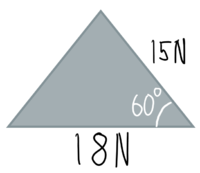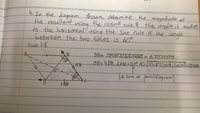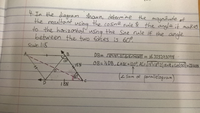Inertia_Squared
Junior Member
- Joined
- May 24, 2019
- Messages
- 54
Hi there, I'm a senior HS student doing engineering in Australia, and I've been having some problems with this one question, I have solved and proven it multiple times but I am never able to get the right answer (that matches the answer sheet), the answers seem a little dodgy (I might explain this at the end but context of the question is required first), so I'd like to know if I'm doing something wrong, or if the answers are wrong.
The question is "In the diagram shown, determine the magnitude of the resultant" (hypotenuse in this specific case) "using the cosine rule and the angle it makes to the horizontal using the sine rule if the angle between the two forces is 60 degrees." In a nutshell, it wants me to find the length of the resultant, and the angle between both the smaller and larger of the forces from the resultant.

I recently re-did the question in a neater format so it was readable, and re-did it only to get the same answer I got last time, which is still different to the question. Because of this, I only proved the resultant and not the angles, as I didn't want to waste my time if I was doing something wrong, and to my knowledge, you will always have to find the resultant first in order to find the angles.
Here is my cleaned up working (dashed line should end up being the resultant if I'm not mistaken):

I always get 28.618N as my resultant, however, the answer states that it is 23N (answers are rounded), with the two adjacent angles being 33* and 26* (this is the dodgy part as the angles should still add up to 60* if rounded correctly but it is close enough, so it still seems legit). Could someone confirm whether or not I have done this correctly and if I have done something wrong, what am I missing?
Thanks for taking the time to read this, I appreciate it!
The question is "In the diagram shown, determine the magnitude of the resultant" (hypotenuse in this specific case) "using the cosine rule and the angle it makes to the horizontal using the sine rule if the angle between the two forces is 60 degrees." In a nutshell, it wants me to find the length of the resultant, and the angle between both the smaller and larger of the forces from the resultant.

I recently re-did the question in a neater format so it was readable, and re-did it only to get the same answer I got last time, which is still different to the question. Because of this, I only proved the resultant and not the angles, as I didn't want to waste my time if I was doing something wrong, and to my knowledge, you will always have to find the resultant first in order to find the angles.
Here is my cleaned up working (dashed line should end up being the resultant if I'm not mistaken):

I always get 28.618N as my resultant, however, the answer states that it is 23N (answers are rounded), with the two adjacent angles being 33* and 26* (this is the dodgy part as the angles should still add up to 60* if rounded correctly but it is close enough, so it still seems legit). Could someone confirm whether or not I have done this correctly and if I have done something wrong, what am I missing?
Thanks for taking the time to read this, I appreciate it!



